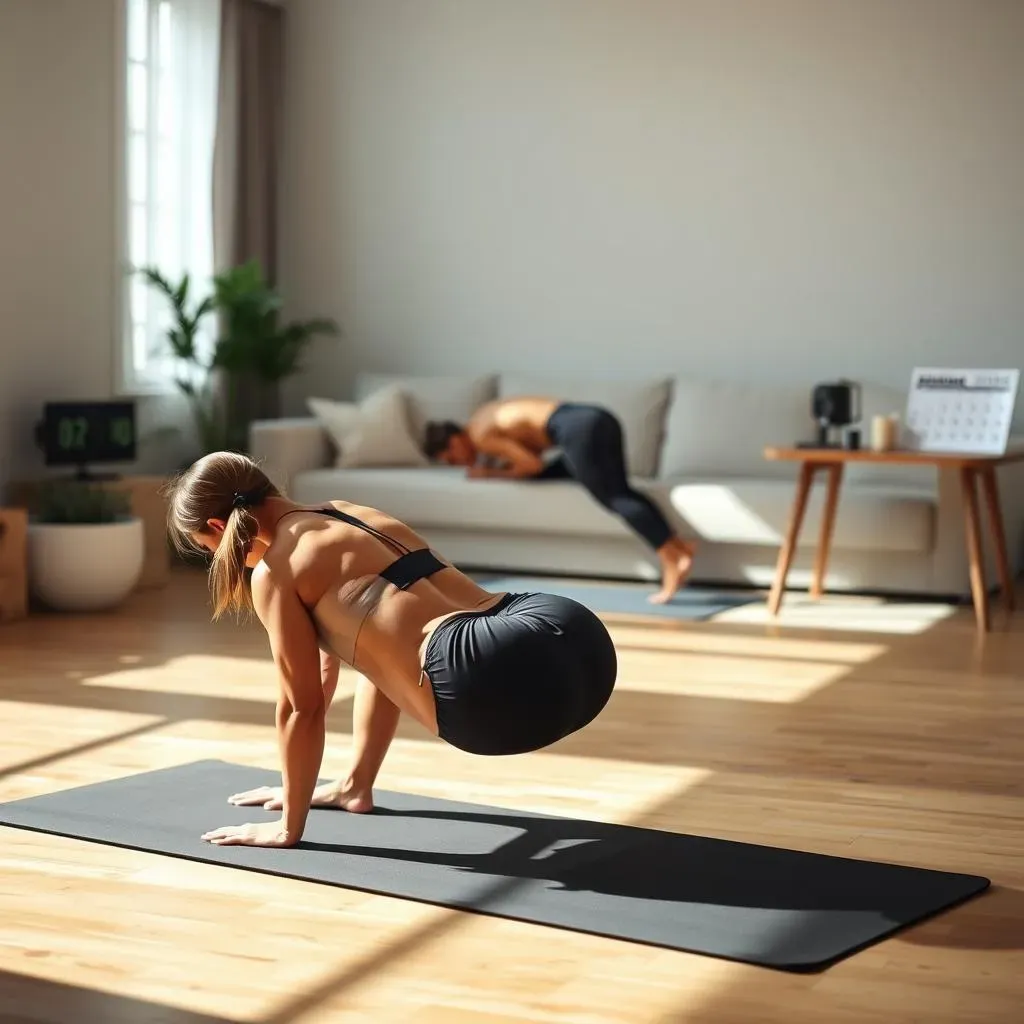Table of Contents
Is your lower back feeling like a rusty hinge? You're not alone. Many of us deal with back pain, and the good news is, you don't need a gym membership or fancy equipment to fix it. We're going to explore simple yet effective low impact back workouts at home that can make a real difference. This article isn't about crazy, complicated routines. Instead, we'll focus on exercises that are gentle on your joints while building strength and flexibility. First, we'll tackle strengthening moves to help stabilize your spine. Then, we’ll move into stretches that will ease tension and improve mobility. Finally, we'll answer some common questions to help you on your journey to a happier, healthier back. Get ready to say goodbye to that nagging pain and hello to a stronger you, all from the comfort of your own home!
Strengthening Your Lower Back at Home

Strengthening Your Lower Back at Home
The Power of Glute Bridges
Let's kick things off with glute bridges, a fantastic exercise. Think of your glutes as the unsung heroes of your lower back. When they're weak, your lower back ends up picking up the slack, which can lead to pain. Glute bridges help wake up those sleepy glutes and get them firing properly. Lie on your back with your knees bent and feet flat on the floor. Then, squeeze your glutes and lift your hips towards the ceiling. Hold for a second, and slowly lower back down. That's one rep. It's like a mini-workout for your backside, and it does wonders for supporting your lower back.
I like to imagine my body forming a straight line from my shoulders to my knees when I'm doing these. This helps me make sure I'm not arching my back too much. Also, don't rush it! A slow and controlled movement is better than a fast and sloppy one. You’ll feel your muscles working, and that's the good stuff.
Planks: Your Core's Best Friend
Next up, we have planks. You might think of planks as just a core exercise, but they're also amazing for your lower back. When you engage your core properly, it acts like a natural corset, supporting your spine. Get into a push-up position, but rest on your forearms instead of your hands. Keep your body in a straight line from head to heels. Hold that position, making sure not to let your hips sag or lift too high. It’s all about that straight line. If you start shaking, it means your muscles are working hard, that's normal. Start with shorter holds, and gradually increase the time as you get stronger.
Planks might seem simple, but they're super effective. They're not about how long you can hold it, but how well you can maintain the correct form. If you're feeling it in your lower back, it might be a sign that your core isn't fully engaged. Try to pull your belly button towards your spine and tighten your abs. This will help engage the right muscles and protect your back. A good plank is like a mini full-body workout, and it's a must for a strong back.
Exercise | Sets | Reps/Hold | Rest |
|---|---|---|---|
Glute Bridges | 3 | 10-15 | 30 seconds |
Plank | 3 | 20-30 seconds | 30 seconds |
The Abdominal Drawing-in Maneuver: Secret Weapon
Ever heard of the abdominal drawing-in maneuver? It might sound complicated, but it's a simple way to strengthen a key muscle called the transversus abdominis. This muscle is like your body's natural back brace, and strengthening it can work wonders for lower back stability. To do it, imagine you're trying to pull your belly button towards your spine, but without holding your breath. You should feel a gentle tightening in your abs. Try doing this while sitting, standing, or even during other exercises. It’s so subtle, you can do it almost anywhere.
This maneuver isn't about big, showy movements, it's about subtle, consistent engagement. It might feel a little weird at first, but with practice, it will become second nature. Think of it as a secret weapon for your lower back. It’s not going to give you a six-pack overnight, but it will make a big difference in the long run. By strengthening the deep core muscles, you're building a solid foundation for all your other exercises and daily activities.
Stretching for Lower Back Relief at Home

Stretching for Lower Back Relief at Home
Knee-to-Chest Stretches: A Gentle Hug for Your Back
Alright, let's move on to stretching, because a strong back also needs to be a flexible back. First up: knee-to-chest stretches. These are like a gentle hug for your lower back, helping to release tension and ease any stiffness. Lie on your back, and bring one knee towards your chest, gently holding it with your hands. Make sure to keep the other leg relaxed on the floor. Hold this position for a few seconds and then switch to the other leg. I like to think of it as gently persuading those muscles to loosen up, not forcing them.
It's important not to pull your knee too hard. You should feel a nice stretch, but not any pain. Think of it as a conversation with your body, not a wrestling match. Also, remember to breathe deeply while you stretch. This helps your muscles relax even more. These stretches are great anytime, whether it's first thing in the morning or after a long day of sitting.
Kneeling Back Stretch: Unwinding the Spine
Next, let's try a kneeling back stretch. This one's great for really unwinding your spine and getting some much-needed relief. Start on your hands and knees, and then gently sit back on your heels. Reach your arms forward, allowing your forehead to rest on the floor. You’ll feel a stretch in your lower back as you do this. It's like a mini-vacation for your spine, giving it a chance to unwind and release any built-up tension. Think of it as a gentle curve rather than a sharp bend, so you don't overdo it.
I think this stretch is fantastic because it's so calming. It’s important to listen to your body and not push too hard. If you feel any pain, ease up a little. Remember to breathe deeply and focus on relaxing. If you're having trouble getting your forehead to the floor, you can put a pillow or a rolled-up towel under your forehead. It's all about finding what feels good and what helps your body release tension.
Stretch | Sets | Hold | Rest |
|---|---|---|---|
Knee-to-Chest | 3 | 20-30 seconds per leg | 15 seconds |
Kneeling Back Stretch | 3 | 20-30 seconds | 15 seconds |
Modified Seated Side Straddle: Releasing Tension
Lastly, let's try a modified seated side straddle. This might sound fancy, but it's really just a way to stretch your hamstrings, abductors, and extensor muscles in your middle and lower back. Sit on the floor with your legs spread apart as wide as is comfortable. Then, gently lean to one side, reaching towards your foot. You don't need to touch your toes, just reach as far as you can comfortably. You’ll feel a stretch along the side of your body and in your lower back. Then switch to the other side. It’s like waking up those muscles and giving them some much needed love.
This stretch is all about finding a comfortable position and not forcing anything. If you're not very flexible, that's totally okay. Just reach as far as you can without feeling pain, and you'll still get a great stretch. It's important to keep your back straight, and to avoid rounding it. I always think of this stretch as a way to open up my body and release any tension that I might be holding onto. Plus, it’s a great way to end any workout to help your muscles recover.
Low Impact Back Workout FAQs

Low Impact Back Workout FAQs
Is it normal to feel some discomfort when starting these exercises?
Okay, so you're diving into these low impact back workouts at home, and you might be wondering if it's normal to feel a little something. It's totally okay to feel some mild discomfort when you're starting out, especially if you haven't been moving much lately. Think of it like waking up muscles that have been snoozing. It's like when you start a new video game; you’re not going to be a pro right away. Your muscles might feel a little sore, but that’s usually just a sign they’re getting stronger. The key is to listen to your body. If it’s a good kind of burn, keep going, but if it’s a sharp, stabbing pain, you should stop and maybe chat with a doctor.
I like to tell people to think of it as a scale. If the discomfort is a 1-3 out of 10, it's probably just your muscles getting used to the work. But if it’s a 5 or higher, it's a sign that you need to back off. Remember, we're aiming for progress, not pain. It’s also important to remember that consistency is key. Don’t push yourself to do too much too soon. Start slow, focus on your form, and gradually increase the intensity as you get stronger. It's a marathon, not a sprint, and your back will thank you for it.
Discomfort Level | What it Might Mean | What to Do |
|---|---|---|
1-3/10 | Normal muscle soreness | Keep going, but listen to your body |
5+/10 | Potential injury or overexertion | Stop and consult a professional |
How often should I do these low impact back workouts at home?
Now, for the million-dollar question: how often should you actually be doing these low impact back workouts at home? Well, the best part is that you can do them pretty frequently, because they are low impact. I generally recommend aiming for 3-5 times a week, but it really depends on your own body and how much time you have. If you're new to exercise, start with 2-3 times a week and gradually increase as you feel more comfortable. It’s like learning a new dance routine; you don’t jump straight into the complicated choreography. It’s better to be consistent than to overdo it and burn out.
I like to think of it as building a habit. Find a time that works for you, whether it's in the morning, during your lunch break, or in the evening. Try to make it a regular part of your routine. Also, don’t forget about rest days. Your muscles actually get stronger when you're resting. So, it's just as important to take breaks as it is to work out. Think of it like charging your phone; you need to plug in to recharge. Listen to your body, and don’t be afraid to adjust your routine as needed. Remember, it’s about making it sustainable for the long haul.
"The greatest of follies is to sacrifice health for any other kind of happiness." - Arthur Schopenhauer
